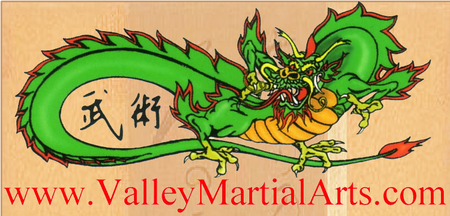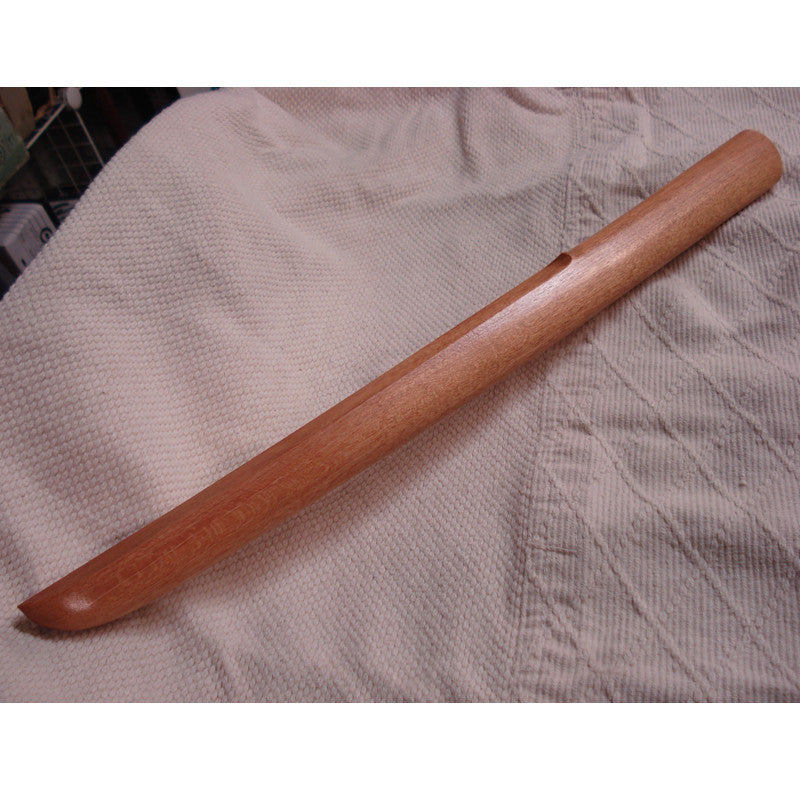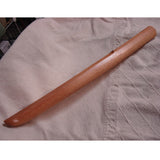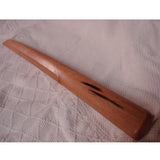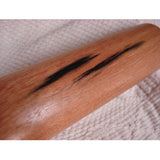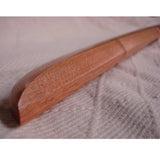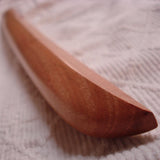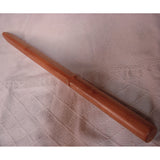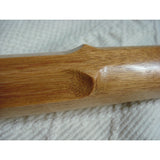I make these myself using all natural products. I was on a short term mission trip to Honduras and I asked the locals what kind of wood is popular for fine wood products. One of the pastors gave me this piece from a fence post. He called it Tatascan and said it is one of the Honduran hardwoods. I can not find any information for it under that name. But I did find some sites that have pictures and describe Honduran Mahogany. Now, I do not know if that is what this is, but it sure looks like it could be, but I cannot confirm it.
The dark streaks on the handle are from where the tips of the nails that were holding the barbed wire ended (it was a fence post). The nails were rusted due to decades of exposure and the rusted tips stained the wood. I really like the way the stained wood looks so I left the stained parts there.
I could not bring any large pieces in my luggage so this size is really all I could make with the little bit that I brought back with me. The picture is of one of the many fence posts found all around Siquatepeque, Honduras. This wakizashi is not from the post in the picture, just from one like it.
Length: 18-12"
Width: 1-1/2"
Thickness: 1"
Weight: 6 ounces
Not recommended for contact against other woods. It most definitely will crack a skull, but remember that these are natural products and they can break and may have internal flaws no one can guarantee against.
What generally differentiates the different swords is their length. Japanese swords are measured in units ofshaku. Since 1891, the modern Japanese shaku is approximately equal to a foot (11.93 inches), calibrated with the meter to equal exactly 10 meters per 33 shaku (30.30 cm).
However the historical shaku was slightly longer (13.96 inches or 35.45 cm). Thus, there may sometimes be confusion about the blade lengths, depending on which shaku value is being assumed when converting to metric or U.S. customary measurements.
The three main divisions of Japanese blade length are:
- 1 shaku or less for tantō (knife or dagger).
- 1–2 shaku for Shōtō (小刀:しょうとう?) (wakizashi or kodachi).
- 2 shaku or more for daitō (大刀?) (long sword, such as katana or tachi).
A blade shorter than one shaku is considered a tantō (knife). A blade longer than one shaku but less than two is considered a shōtō (short sword). The wakizashi and kodachi are in this category. The length is measured in a straight line across the back of the blade from tip to munemachi (where blade meets tang). Most blades that fall into the "shōtō" size range are wakizashi. However, some daitō were designed with blades slightly shorter than 2 shaku. These were called kodachi and are somewhere in between a true daitōand a wakizashi. A shōtō and a daitō together are called a daishō (literally, "big and small"). The daishō was the symbolic armament of the Edo period samurai.
A blade longer than two shaku is considered a daitō, or long sword. To qualify as a daitō the sword must have a blade longer than 2 shaku (approximately 24 inches or 60 centimeters) in a straight line. While there is a well defined lower-limit to the length of a daitō, the upper limit is not well enforced; a number of modern historians, swordsmiths, etc. say that swords that are over 3 shaku in blade length are "longer than normal daitō" and are usually referred to or called ōdachi. The word "daitō" is often used when explaining the related terms shōtō (short sword) and daishō (the set of both large and small sword).Miyamoto Musashi refers to the long sword in The Book of Five Rings. He is referring to the katana in this, and refers to the nodachi and the odachi as "extra-long swords".
